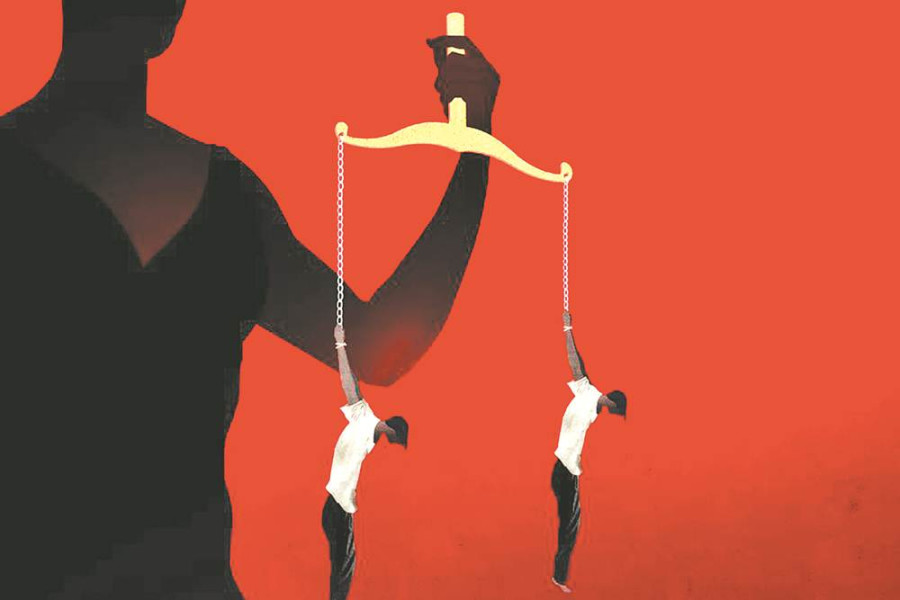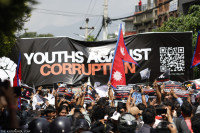Opinion
Still in the Middle Ages
Torture has yet to be criminalised and it is seen as a legitimate method of investigation
Randhir Chaudary
A year ago, an elderly resident of Dhanusha district was tortured by a policeman from the Laliya Police Office for lodging a First Information Report (FIR) along with evidence that his 14-year-old daughter had been trafficked and sold illegally into marriage. The senior citizen was severely beaten with a stick on his feet, back, palms and other parts of the body by the police officer who was under the influence of alcohol. There is a worrying trend of state forces continuing to regularly employ torture even in these post-conflict times. For example, 25 percent of the 4,247 detainees interviewed in 2011 said that they had been tortured.
The situation in the Tarai region appears to be worse than in other parts of Nepal. The many instances of torture demonstrate a range of motivations for torture being employed by the police. Detainees are tortured in order to obtain bribes and confessions or obstruct the administration of justice. Sometimes, the motivation is sexual pleasure or pure frivolity. Torture in Nepal is well documented. The United Nations Committee against Torture concluded in 2011 that “torture is being systematically practiced in the territory of Nepal… mainly in police custody”. Towards the end of the Maoist conflict, the Special Rapporteur on Torture found that torture was systematic and used to extract confessions and obtain intelligence. In the years following the conflict, human rights organisations in Nepal have extensively documented a persistent trend of the use of torture by the state security forces.
Broken system
While Nepal has adopted the Compensation for Torture Act, 1996 to enhance the country’s implementation of the Convention against Torture and Other Cruel, Inhuman or Degrading Treatment or Punishment (the Torture Convention in short), the compensation payments made to torture victims are very limited. The 35-day statute of limitations for filing a complaint defeats the purpose of the law. In addition, there is a maximum limit of Rs100,000 for compensation payments, but no minimum limit has been set. Ironically, the defence counsel for the perpetrator is the state prosecutor and the victim has to pursue the claim using his or her own resources. There are also no witness protection laws, which results in many of the victims being reluctant to come forward or file compensation claims because of a real fear of antagonising the perpetrator or arousing revenge by the police.
Perhaps what is even more worrying is that torture has yet to be criminalised in Nepal. On May 23, 2009, the Supreme Court of Nepal ordered the government to formulate legislation criminalising torture, but till date only a draft bill criminalising torture has been released. It has yet to be signed into law. To be frank, there are some practical challenges which prevent the bill from being signed into law. Civil and political liberties, including the right not to be tortured, are not given priority in national discourse because development issues have been getting all the attention.
Furthermore, there is strong political and community pressure to tackle the problem of widespread criminality in the Tarai where there has been historically little presence of the state which subjects the inhabitants to a persistent sense of vulnerability. There has, therefore, been tacit support for the use of strong-arm tactics by the police. Consequently, in several cases, human rights defenders have been unable to carry out effective investigation due to a fear of reprisals and resistance from the local community. In addition, such societal attitudes encourage impunity and continued use of torture by the state security forces.
Enact the law
First and foremost, the draft bill criminalising torture should be approved with some amendments on an urgent basis. After that, the following institutional and administrative steps must be taken: Ratifying the optional protocol to the Convention against Torture and putting in place a national monitoring mechanism of torture; criminalising witness or victim intimidation; establishing a witness protection programme to decrease the fear of retaliation; extending the statute of limitations for filing cases involving torture; increasing the upper limit of compensation payment and establishing a lower limit; removing the provision allowing perpetrators to be defended by the government attorney and providing legal services to victims instead; and reforming the police structure to include representation of Madhesi police officers in the Tarai region in order to reduce discrimination against Madhesi citizens.
Intensive steps to fight torture should also be taken by including the elimination of torture as a priority in national discourse and actively changing societal perceptions (including that of the police) of torture as a legitimate method of investigation. Specifically, law enforcement personnel should be trained in methods of interrogation and confinement that preclude the use of torture. Resources should also be invested in improving the methods of criminal investigation so as to instil a culture of proper investigations and obtain legitimate and admissible confessions.
Furthermore, the state should be proactive in investigating acts of torture and ill treatment even if no formal complaint has been lodged. This is in line with the guidelines set out in the Istanbul Protocol. In short, reforms should be conducted so that Nepal adheres to the following statement written by Jeremy Waldron, a New Zealand professor of law and philosophy: “Law is not brutal in its operation; law is not savage; law does not rule through abject fear and terror, or by breaking the will of those whom it confronts. If law is forceful or coercive, it gets its way by methods which respect rather than mutilate the dignity and agency of those who are its subjects.”
Chaudhary is associated with the Tarai Human Rights Defenders Alliance




 13.12°C Kathmandu
13.12°C Kathmandu










